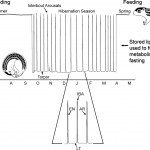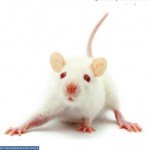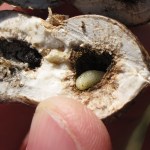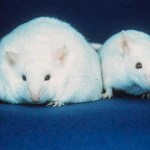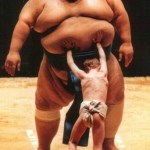fat
I know this is not a comparative physiology topic, but this article caught my attention as I know I just ate a rather high fat meal last week for Thanksgiving and I plan to do the same throughout the holiday season.
Insulin does more than just lowering blood sugar by increasing its uptake into tissues. It can also increase blood flow to the hippocampal region of the brain to help cognitive function. This area of the brain is important in memory formation and spatial orientation. A new study published in the American Journal of Physiology - Endocrinology and Metabolism used…
Sketch of a rainbow trout from Wikimedia Commons
Ceramides are a type of sphingolipid composed of both fatty acids and sphingosine that are important in maintaining the structure of cell membranes and cell signaling pathways. Given their structure, it is perhaps not surprising that levels of ceramide are increased in the brains of mammals after eating a diet high in fats as well as in individuals who are obese. In mammals, ceramides are also known to help regulate food intake.
Since rainbow trout (Oncorhynchus mykiss) do not rely on glucose as…
I LOVE THIS MEETING!
DAY 3 included several very interesting comparative physiology sessions.
Image of birds from Wikipedia
Eldon Braun (University of Arizona) spoke about how birds have a unique way to prevent water loss and thereby dehydration. In mammals, the kidneys are responsible for recovering water from the urine. However when birds are well-hydrated, the urine enters the colon and moves backwards up the gastrointestinal tract to facilitate water reabsorption prior to voiding the urine.
Hiroko Nishimura (The University of Tennessee) spoke about work she had done over the years…
Image of ruby-throated hummingbird by Joe Schneid, Louisville, Kentucky (Own work) [CC BY 3.0 (http://creativecommons.org/licenses/by/3.0)], via Wikimedia Commons
In a new study published in The Auk, scientists report that well-fueled older tiny Ruby-throated Hummingbirds (Archilochus colubris) might be capable of non-stop flights of over 4,000 kilometers, wind conditions permitting. They made this remarkable observation while studying birds from 2010-2014 as the animals made stopovers at a wildlife refuge during their annual migration to South…
Image from the American Physiological Society's website.http://www.the-aps.org/mm/Conferences/APS-Conferences/2014-Conferences/…
Wednesday was the last day of the meeting that culminated in a closing banquet with an awards session to honor students who had exceptional presentations. What an impressive group of young comparative physiologists! The plenary lecture was given by Dr. Steven Chown (Monash Univ, Australia). He spoke about climate change forecasts and continuing environmental changes and how important it is to understand how animals adapt to changing conditions in order to…
Image of electroacupuncture to the back from www.sandiegohealingarts.com
A new study published in AJP-Regulatory, Integrative and Comparative Physiology suggests that electroacupuncture to the abdominal region may prevent increases in blood sugar concentrations after a meal by affecting insulin sensitivity and circulating free fatty acid concentrations. Granted this is not comparative physiology research, I find it interesting that electrical stimulation can have such a large impact on metabolism, in mice at least.
Drs. Nicola Abate and Jiande Chen, lead investigators…
Shivering is one mechanism by which heat is produced in the body. Heat production is called thermogenesis. Another mechanism is through nonshivering thermogenesis regulated by brown fat (i.e. adipose). This second type of heating mechanism kicks in when we need extra heat production such as a postnatal infant, someone developing a fever, an animal arousing from hibernation, eating, or in the case of the current study, stress.
A recent study published in the American Journal of Physiology provides evidence that during stressful events brown adipose tissue can elevate body temperature through…
I have heard of some animals using sugars as antifreeze (check out the prior blog on wood frogs that freeze and survive!), but never lipids.
Image from http://thebuggeek.com/tag/eurosta-solidaginis/
Researchers have discovered that larva of the Goldenrod gall fly (Eurosta solidaginis) shown above survive nearly freezing solid as well, which they hypothesize may be accomplished by accumulating acetylated triacylglycerol, or agTAGs, (i.e. a type of lipid) during winter. They found that the flies accumulate this lipid from September through March and studies of the agTAGs show that this…
Drs. Chia Soo and Bruno Péault, from the Eli and Edythe Broad Center of Regenerative Medicine and Stem Cell Research at UCLA, have found a way to turn stem cells from fat tissue into bone of higher quality than that grown with prior techniques.
The mesenchymal stem cells (MSCs) isolated from the fat tissue may develop into bone, cartilage, muscle as well as other tissues. More importantly, fat tissue is easily accessible through liposuction.
What is unique about their research is that they were able to purify stem cells from fat tissue relatively quickly. Until now, the…
Note the double question mark. That is because I'm quoting Can we Grow the Economy Any More? I'll let you go off and read that post now, if you like.
Done so? Good. Now for my ignorant rant:
What strikes me particularly is point 6, or a variant thereof: effectively, that we're too fat, as a society. We're so rich that it is barely worth our time picking off the parasites. By parasites I don't mean the low skilled workers, or even the discontent rioter-types - because broadly speaking, those types stay in the background and are quietly bought off. I mean the H+S zealots, OFSTED (bit of a UK-…
Photo by flickr user gato-gato-gato.
Did you ever watch cattle? I mean, really watch them, for a few hours? Mostly they just sit or stand around munching on grass, chewing their cud, or snoozing. But every once in a while a handful of them will stand up and point in one direction. And they may take a few steps in that direction. Then a few more will join them. And once a critical mass has been reached, the whole herd will just go. Domestic cattle, wild African cape buffalo, whatever. This is what they do.
And as the cattle do, so do bloggers. And one day one, then another, then another of…
Macrophages are really good at gobbling stuff up. It's all right there in the name - they are big (macro) eaters (phage). I study them in the context of the immune system - one of the things they do really well is eat up bacteria and other pathogens that have found their way into your tissues. As a front line sentinel, they also are capable of kick-starting inflammation and recruiting the rest of the cells necessary to clear an infection. But that's not all, there's more.
Weight loss and lipolysis promote a dynamic immune response in murine adipose tissue
Here we characterized the response of…
That's right - contrary to what many religiously believe, it is the inability to grow more fat during times of energy surpluss, rather than the excess of fat which appears to directly contribute to the metabolic consequence often associated with obesity.
A recent article in the New Scientist shines some light on this issue;
Obesity kills, everyone knows that. But is it possible that we've been looking at the problem in the wrong way? It seems getting fatter may be part of your body's defense against the worst effects of unhealthy eating, rather than their direct cause.
While the article…
The Not Exactly Pocket Science experiment continues after the vast majority of people who commented liked the pilot post. I'm really enjoying this, for quite unexpected reasons. It's forcing me to flex writing muscles that usually don't get much of a workout. Writing short pieces means being far more economical with language and detail than usual. It means packing in as much information as possible while still keeping things readable. And it means blitz-reading papers and writing quickly without losing any accuracy.
One quick note before the good stuff: last time, a few people suggested that…
tags: man drinking fat, NYC Health Anti-Soda Ad, Are You Pouring on the Pounds?, diet, nutrition, sports drinks, soda, sweetened drinks, television, disgusting, streaming video
Most people don't realize how easy it is to gain weight from drinking sugary sodas, juice drinks, sport drinks and sweetened tea and coffee drinks. Just one 20-ounce bottle of soda can pack 250 calories and more than 16 teaspoons of sugar. Is the lemon-flavored iced tea any better? Not by much with 210 calories and 14½ teaspoons of sugar. Sugar-sweetened beverages add hundreds of calories to your diet each day. Don't…
Aquarium staff at Kinosaki Marine World in western Japan recently noticed that their dolphins were less acrobatic in their performances and more lethargic in general. Concerned about their health, the dolphins were weighed and found to be significantly heavier since only a few months prior. Apparently a fattier mackeral, their typical breakfast, lunch, and dinner, was to blame. Aquarists quickly started calling the dolphins "fatty" and "fatty-fat-fat" and telling them no one would love them in an effort to get them to throw-up their meals after eating them. When that failed, they tried…
Apparently obesity isn't just for American's anymore... make that humans in general. First we have George, the greedy little pig as old British women would call him. This hedgehog was delivered to the Wildlife Aid centre in Leatherhead, England five times heavier than his natural weight. At 5lbs, George is dangerously obese and a testament to the fattening properties of garden insects, fruits and mushrooms.
Remind anyone else of this?
More of a trailer park tiggywinkle if you ask me.
Next we have Peaches, the fat baby wombat, from Tomerong, north of Sydney. In this series of caught-in-the-…
